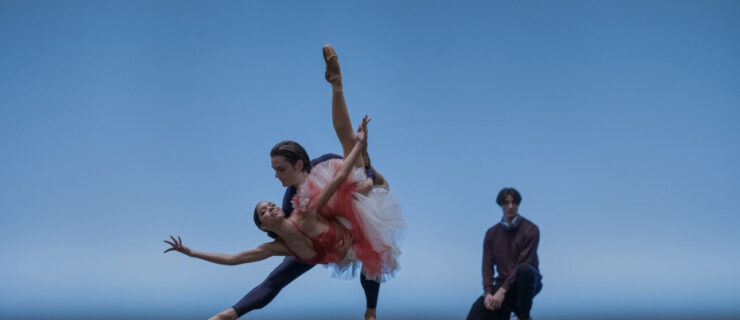Slip Sliding Away
Imagine a tap dancer who moves as if she’s on slick ice. While one foot does a quick shuffle, the other slides backwards. She does a scuff and her supporting foot slides forward beneath her. And then, to top off this slippery magic act, she takes a few running steps and does a long slide,

skimming over nearly the entire length of the stage.
Tap slides are an artist and audience favorite and add variety to a performance. “The sound of a slide is very subtle, but it has a strong visual impact,” says Roxane Butterfly, an internationally renowned tap dancer. A tapper mid-slide appears to float effortlessly, creating a feeling of suspense.
While you may not have tried tap slides before, dancers have been impressing audiences with this smooth move for decades. And not only are slides fun to do, but mastering the balance needed to pull one off can also help in other areas of your dancing.
Super Slider
Slides are widely associated with the late James Godbolt (1927-2008), who, thanks to his mastery of the step, is better known as Jimmy Slyde. “Ask anyone who the all-time best slider is and the answer is Jimmy Slyde. Jimmy was the slide!” says Mark Goodman, an L.A.-based tap teacher and artistic director of the Mark Goodman Tap Company. “Slyde’s dancing was like butter on a hot stove. He was so graceful. You never saw him work. You just saw him move across the stage.”
While dancers had performed slides long before Slyde’s time, he and Jimmy “Sir Slyde” Mitchell popularized the step in an act called The Slyde Brothers. The two dancers met in the 1940s while studying at Stanley Brown’s dance studio in Boston and learned the move from their teacher, Eddie Ford, a slide specialist. The duo toured with the era’s best big bands, including Duke Ellington’s group and the Count Basie Orchestra.
Later in life, Slyde served as an important mentor to many young tap artists, passing down his artistry and the secrets of the slide. He was Butterfly’s mentor—in fact, he was the one who dubbed her “Butterfly” because of her light feet.
Flying Across the Floor

So you want to skate across the stage like Slyde? Slides work best on a polished wood floor, which allows you to glide easily (and for great distances!). The key to successful sliding is body positioning. “Jimmy Slyde’s body was upright the whole time,” Goodman says. “You can’t slide bent over. Your body has to be up and slightly back, although not too far back or you’ll fall.”
Goodman recommends learning to slide on both feet first. While a running start will ultimately give you the most momentum, it’s best to start slowly, so that you can find your balance. “Take two easy steps,” Goodman says. “Step right, step left and then push off the left foot as the right foot shoots out in front.” Center your weight over the inside of your left thigh, and maintain the width and depth of the foot position that you start with. It’s also helpful to keep your arms out to the side and slightly bent, which will allow you to adjust your balance as you move.
One last tip for learning slides: Don’t be afraid to fall! “People fall all the time,” Goodman says. “You fall once or twice and then you’ll figure it out. I love it when my students fall because it means they’re really trying.”
Beyond Simple Slides
Once you’ve achieved at least a 10-foot slide on both feet, you can attempt single-foot slides and experiment with sliding in different directions. Jessie Sawyers, the founder of SoleSound Visual Music Production, a Seattle-based dance, performance and music company, says sliding backwards may look different than a forward-moving slide, but uses a lot of the same techniques. For backwards slides, she recommends preparing in plié with your arms extended in front of you, crossed or bent, ready to propel your body backwards. Lift your body with your core muscles to slide backwards, and swing your arms down and back to give yourself an extra push. “Be sure to keep your weight centered over your feet,” Sawyers says, “and don’t completely straighten your knees.”
While walking and sliding is fun, to really master the move you have to be able to connect it to other steps. “It’s best to use steps that have momentum, like a run or a flap, and then you can throw a slide in wherever you want,” Goodman says.
After becoming comfortable with the technique and rhythm of slides, you can add them to your improv repertoire. But be ready for the challenge. “You never know for sure just how long your slide will last or how your momentum will end,” Sawyers says. “That’s part of the fun of slides. It’s a mystery for you and for the audience.”
Extending Lessons from the Slide
Performing the slide requires a complete integration of your arms, core and legs in order to find and maintain your balance as you glide 10, 20 or even 30 feet! The total body awareness that comes from practicing slides will help you with other tap steps that also require balance, such as pullbacks and switching wings. And even if your focus is ballet or jazz, learning slides will help you balance, turn and sustain movements in those forms, too.
But for aspiring hoofers, slides are a must-have move. “Instead of hard-hitting all of the time, slides bring smoothness,” Butterfly says. “They make you cool.”
Darrah Carr is a New York–based choreographer, educator and writer, active in both the Irish and modern dance communities.
Photos top to bottom: Jessie Sawyers teaching a tap workshop at Dance Time in Kirkland, WA, by Fayme Way; Roxane Butterfly (right) and her mentor, Jimmy Slyde, at the 1996 Urban Tap premiere at The New School, photo by Paolo Vescia.



